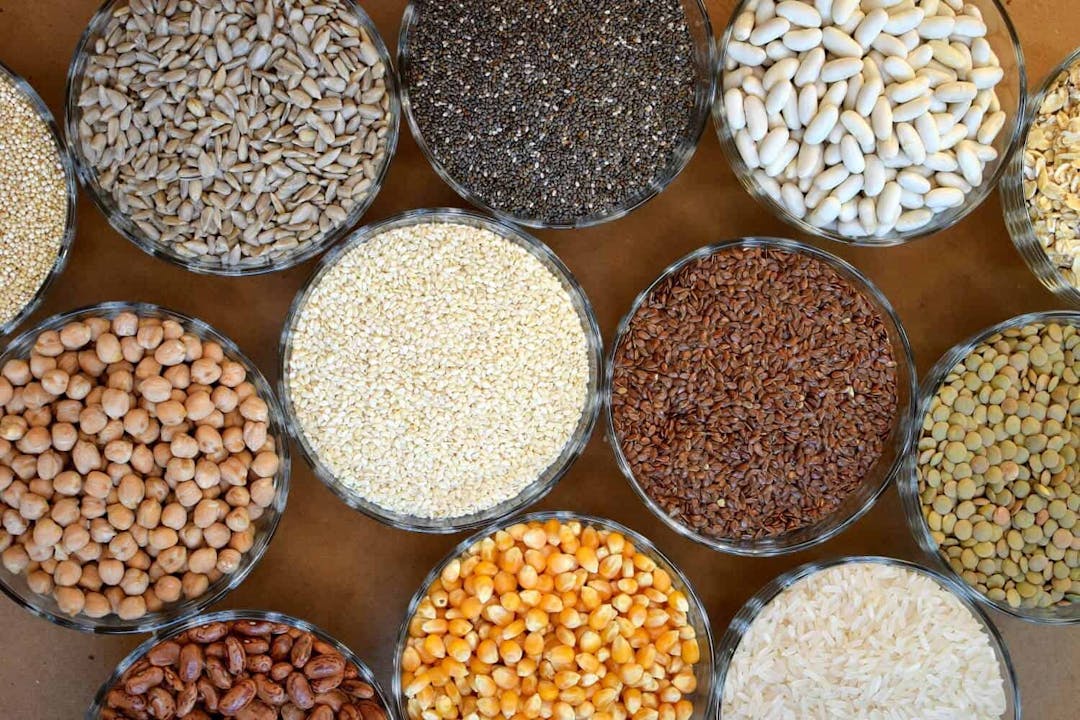


Find foods you can eat.
Introduction to a Low Iodine Diet
Published on October 20, 2022What is a Low Iodine Diet?
A Low Iodine Diet (LID) is prescribed to thyroid cancer patients who will be undergoing radioactive iodine treatment (RAI) to ablate or kill off any possible remaining thyroid tissue following surgical removal of the thyroid gland. It is also prescribed to those undergoing a RAI scan (Whole Body Scan) and to those having ablation treatment for hyperthyroidism.
Thyroid tissue is uniquely the only body tissue that utilizes iodine. The purpose of the low iodine diet is to reduce the level of iodine in the body so that any remaining thyroid tissue is “thirsty” for the iodine contained in the radioactive iodine ingested as treatment. That is, thyroid tissue depleted of iodine is more apt to uptake the RAI and thereby be ablated by it. If a follow-up scan is necessary, RAI may be given in a smaller dose and in that case the RAI acts as a contrast media to “light up” any remaining thyroid cells in the body.
Who should follow a Low Iodine Diet?
Patients who will be undergoing radioactive iodine treatment or a RAI scan (also known as I-123 scan, I-131 scan, or Whole Body Scan) are advised to follow a Low Iodine Diet for 14 days prior to the dose of RAI and 24-48 hours post treatment. Instructions may vary with particular circumstances. The low iodine diet is a temporary and very specific diet. Other people and thyroid cancer patients who are not preparing for RAI treatment should not be on the low iodine diet, as there would be no health benefit and the food choices may lack in full nutritional balance due to the restrictions.
How to follow a Low Iodine Diet
A Low Iodine Diet means that you should have foods and drinks that contain as little iodine as possible. Iodine is a mineral found naturally in many foods, especially those from the sea.
In various countries, iodine is added to selected table salt as an optional version of the salt. In some countries, such as Canada, it is added to all table salt by regulation. This is called iodized salt. Iodine is not added to coarse salt, Kosher-style coarse salt, or pickling salt.
On a low iodine diet, the total amount of iodine you take in each day should be less than 50 micrograms (mcg). This will be much less than you are used to having. For example, the amount of iodine allowed on this diet in a day is equal to the amount found in less than 1/8 teaspoon of iodized table salt.
To lower iodine in your diet:
• choose foods and drinks low in iodine
• prepare foods and drinks without adding iodine
Is a Low Iodine Diet the same as a Low Sodium Diet?
No. Salt is also called sodium chloride. You need to avoid iodized table salt and sea salt because they contain iodine, not because they contain sodium. You can still have foods with sodium if they are low in iodine. For example, you can salt your food with non-iodized salt or coarse salt which you purchased for that purpose. You cannot however purchase foods with “salt” listed in the ingredient list of a food product, as government regulation does not compel manufacturers to specify whether the salt in the product is iodized.
Foods high in iodine
Many foods are high in iodine. For example, iodine is found:
• in iodized salt and foods containing iodized salt
• naturally in many foods such as fish and other sea foods
• in dairy products, because iodine occurs naturally in milk and because the solutions used to clean cows and milking equipment may contain iodine
• in foods colored with red food dye (erythrosine/red dye #3)
• in breads using iodate bread conditioners
• in egg yolks, or products containing eggs as an ingredient
Do not eat foods and drinks that contain high levels of iodine. Soy protein is also to be avoided because it has a quality that may block uptake of RAI (soy oil and soy lecithin are LID-allowed).
Use the Fig app to find foods at the grocery store low in iodine. Green foods on the app are likely low iodine while red foods should be completely avoided.
Is iodine listed on nutrition labels?
The “Nutritional Facts” list on a food product’s label is not relevant to the low iodine diet. The relevant aspect to the LID is the ingredient list. This list is usually written in paragraph form with commas between each ingredient. It is this list that needs to be scrutinized carefully to be sure there are no LID-avoid ingredients.
You can use the Fig app to quickly check if a product’s ingredients likely have iodine. Simply scan a product’s barcode, and the app will highlight any ingredients with iodine.
The most important foods to AVOID while on the low iodine diet are:
- Any product from the ocean, including fish, seafood, seaweed and sea-salt
- Iodized salt, or any food with salt in the ingredient list
- Any dairy product, including milk, cream, butter, yogurt, cheese, etc.
- Red Dye #3 (Erythrosine) used as food coloring in some red candies, powdered drinks, colored cereals and some medications. If a food product is red because of food coloring and not labeled, avoid it. Talk to your doctor if your medication is colored with red dye (such as some cough syrups). An alternative may be available
- Commercially-prepared breads or other baked goods, as many use iodate conditioners and they may not be explicitly labeled
- Egg yolks, or foods labeled as containing eggs. Homemade foods using only the egg-whites are low iodine diet allowed
For more details and a complete listing, checkout this list from Everyday Thyroid Cancer.
Medications and Medical Tests to avoid on a Low Iodine Diet
Multivitamins usually contain iodine and are to be avoided. Other medications need to be scrutinized as they may contain dairy ingredients. Some medications, especially some forms of calcium, may contain ingredients from the sea, such as kelp, glucosamine, chondroitin, selenium, coral or oyster shell calcium. If you must take calcium (eg. for hypoparathyroidism), speak to a pharmacist about taking a differently-sourced form of calcium. As well, some medications for cardiac arrhythmia such as Amidarone contain iodine. Speak to your doctor about alternatives. Topical iodine (e.g., surgical skin preparation), skin creams or antiseptics made with iodine such as betadine, Lugol solution, or saturated solution of potassium iodide, are to be avoided. If possible and cleared by your doctor, avoid Thionamide medications (e.g., propylthiouracil, methimazole carbimazole).
Some administered CT scans include the use of a contrast media given by injection. The contrast media is primarily made of iodine. Therefore, if you have had a CT scan with contrast, you will likely need to delay your RAI treatment for a few months. Speak to your treating doctor about the necessary interval.
Low Iodine Diet Recipes and Meal Ideas
Here are suggested low iodine diet recipes from Everyday Thyroid Cancer.
In order to have full control of all ingredients, prepare home-made foods “from scratch”. Avoid food packages with multiple processed food ingredients. Have unsalted vegetables and fruits on hand for side dishes and snacks. Add flavor with fresh or dried herbs, salt-free spice mixes, vinegar and non-iodized salt. Hide or move your usual salt shaker so that you don’t accidentally use it. We suggest you plan ahead and prepare meals in advance, including freezing portion-sized meals.
Almost all plain grain products are very low in iodine, such as rice, quinoa, couscous, buckwheat and pasta (except egg noodles). Therefore, meals prepared with large portions of grains, vegetables, and low portion sizes of beef or chicken are an excellent source of nutrition and low in iodine. However, you must be very mindful of the ingredients you add as seasoning or toppings to be sure they are LID-allowed.
Other easy meals are vegetable or beef stew, or soups. Also, chicken, pork or beef prepared from its raw, unseasoned state, and served with vegetables, potatoes, or grain side-dish are low-iodine as long as you are mindful of the seasoning and toppings you add.
If you have a family member or friend who likes to cook or bake, supply them with suitable ingredients and recipes allowed on the low iodine diet. Be sure to emphasize that there can be no substitutions in the recipes. They would likely be happy to help support you. Or, have a “kitchen party” where you invite friends to help you prepare meals in advance and freeze them.
Low Iodine Diet Breakfast ideas
Low iodine diet breakfast meals can include hot oatmeal or salt-free cereals. Egg-white omelets are also allowed on the low iodine diet, as most of the iodine in eggs is in the yolk.
Dairy is not allowed on the low iodine diet; however, there are many milk-substitutes now available which are LID-allowed. These plant-based milks, which are salt-free and dairy-free, include coconut milk, oat milk, hemp milk, rice milk, pea protein milk, etc. Likewise, there are non-dairy yogurts and butter-substitutes that meet the requirements of the low iodine diet.
You can find more low iodine breakfast products on the Fig app and a listing of milk-substitutes and butter-substitutes on the Everyday Thyroid Cancer LID page (in the Guides section).
Low Iodine Restaurants and Fast Food Options
It is advisable to avoid all restaurant foods while on the low iodine diet, as there are several pitfalls that may not be avoidable. For example, breads very likely contain iodate conditioners, food may be salted with iodized salt, and iodine-based cleansers (iodophor sanitizers) are often used in restaurant kitchens.
Packaged prepared meals are also to be avoided as they often contain a multitude of ingredients, including salt, and it is difficult to ascertain the compatibility of all the ingredients in regards to maintaining the LID.
Low Iodine Diet Shopping List
Checkout this Low Iodine Diet Shopping List PDF from Everyday Thyroid Cancer.
If you’re going to the grocery store, the easiest way to build your low iodine diet shopping list is by using the Fig app. Fig lets you select your grocery store and then shows you thousands of products that are likely low in iodine at that grocery store. The Fig app is free to download and search for products.
Everyday Thyroid Cancer provides additional resources:
About the author
Rita Banach is co-founder of Thyroid Cancer Canada and was its president from 2000-2016. Following her own diagnosis of Papillary thyroid cancer in 1999, she found information and support for patients was lacking. That became the impetus for her study of the disease, publishing various patient education materials, and co-authoring medical journal articles. In consultation with 50 experts, in 2006 Rita co-authored Food Guide for a Low Iodine Diet. Since 2015, Rita has been offering support to patients via Everyday Thyroid Cancer.
Photo by Sonny Mauricio on Unsplash
 Low FODMAP Grains and Pulses
Low FODMAP Grains and Pulses Low FODMAP restaurants: Tips for Eating Out Low FODMAP
Low FODMAP restaurants: Tips for Eating Out Low FODMAP